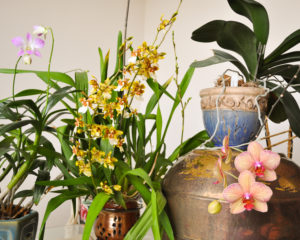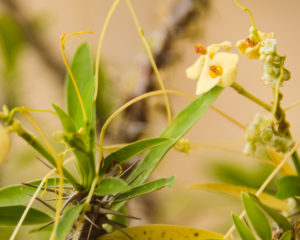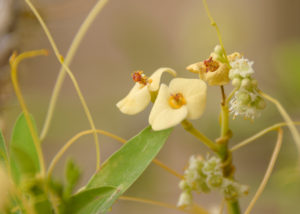Doddery Monday
Double-click on any image to view it full size. Click the back-button to return to your place on this page.
Greetings!
For the past few days Ruthi and I have had house guests. This had been great fun, but as a result I have neglected my duties, and have not spent the necessary time and diligence to put together a weekly essay! Therefore I have rather than just declaring a holiday, I have blown the dust off an article I wrote for our building monthly newsletter several months ago in the hope that it will be of general interest.
Many of us keep houseplants to beautify our homes. Ruthi and I had a collection of orchids, part of which is shown in picture #1,

but, like so many such plants, they eventually succumbed to insect infestation. (We suspect the insects were introduced on a “rescue” orchid.) Most people have seen typical plant-pest insects such as the (outdoor) white Woolly Alder Aphids shown in picture #2.

However, I suspect very few of us have seen an indoor plant, in Virginia, hosting a truly parasitic plant! But such was the case with one lucky(?) neighbor about eighteen months ago, who asked me to look at a strange group of thin yellow strings that were draped on a Crown of Thorns plant in her home. I was able to identify this as a species of Dodder (Latin name Cuscuta). It turns out that she had recently brought this plant inside for the winter, and the Dodder must have come inside with it. In pictures #3 & #4, the long yellowish stems and tiny white flowers belong to the Dodder, while the green leaves, brown thorns and larger creamy flowers belong to the Crown of Thorns.
Dodder grows from seeds, but the shoots of the young plant must find a host to wind around, since they have virtually no leaves and not enough chlorophyll to produce food for themselves. When a seed germinates, the young plant can live for about ten days on the nutrients in the seed. The seedlings seem to have some ability to “smell” and grow towards a suitable host plant if there is one within reach – otherwise they will die. Having found a host, the tendrils produce projections called “haustoria”, which intrude into the host plant’s vascular system, and through which the Dodder henceforth obtains all its water and nutrients. The Cuscuta species are very distantly related to the morning glory family, but are among the very few plants that are truly parasitic. You can read more about these fascinating guys at http://oak.ppws.vt.edu/~flessner/weedguide/cvcca.htm , http://www.fcps.edu/islandcreekes/ecology/dodder.htm , or the old standby Wikipedia, https://en.wikipedia.org/wiki/Cuscuta . http://climbers.lsa.umich.edu/?p=223 also has some interesting information about the etymology of the name Dodder, and about an alleged Pawnee superstition about the plant!
Have a great week!

